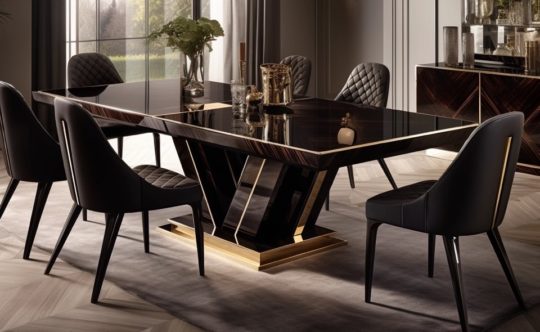Luxury living room interior design guide
Unlock the secrets to achieving a sophisticated and inviting atmosphere with our comprehensive guide to luxury living room interior design, where elegance, comfort, and functionality are expertly balanced to create a truly exceptional space.
The living room is often the heart of every home, a space that’s enjoyed by family and friends, where you spend quality time and entertain your guests. It’s a multipurpose space that must meet the needs of many different functions and experiences. Whether you are hosting elegant soirées, enjoying a quiet evening with loved ones, or simply relaxing after a long day, your living room should be a sanctuary of comfort and style, where luxury meets practicality.
Creating a space that seamlessly combines elegance, comfort, and functionality doesn’t happen by accident, it requires careful consideration and planning. Meeting the diverse requirements of space, flow, and purpose for such a multifunctional room can be daunting. That’s why we have created this comprehensive living room interior design guide. It will help you navigate the complexities of luxury living room design, ensuring every detail is thoughtfully considered to enhance both your lifestyle and your home’s aesthetic appeal.
Jump to:
- Design inspiration
- Colour scheme
- Space planning
- Factors to be considered when planning your room layout
- Selecting the right furniture
- Selecting the right materials and finishes
- Why work with an interior designer?
- Luxury Interior Design, London UK
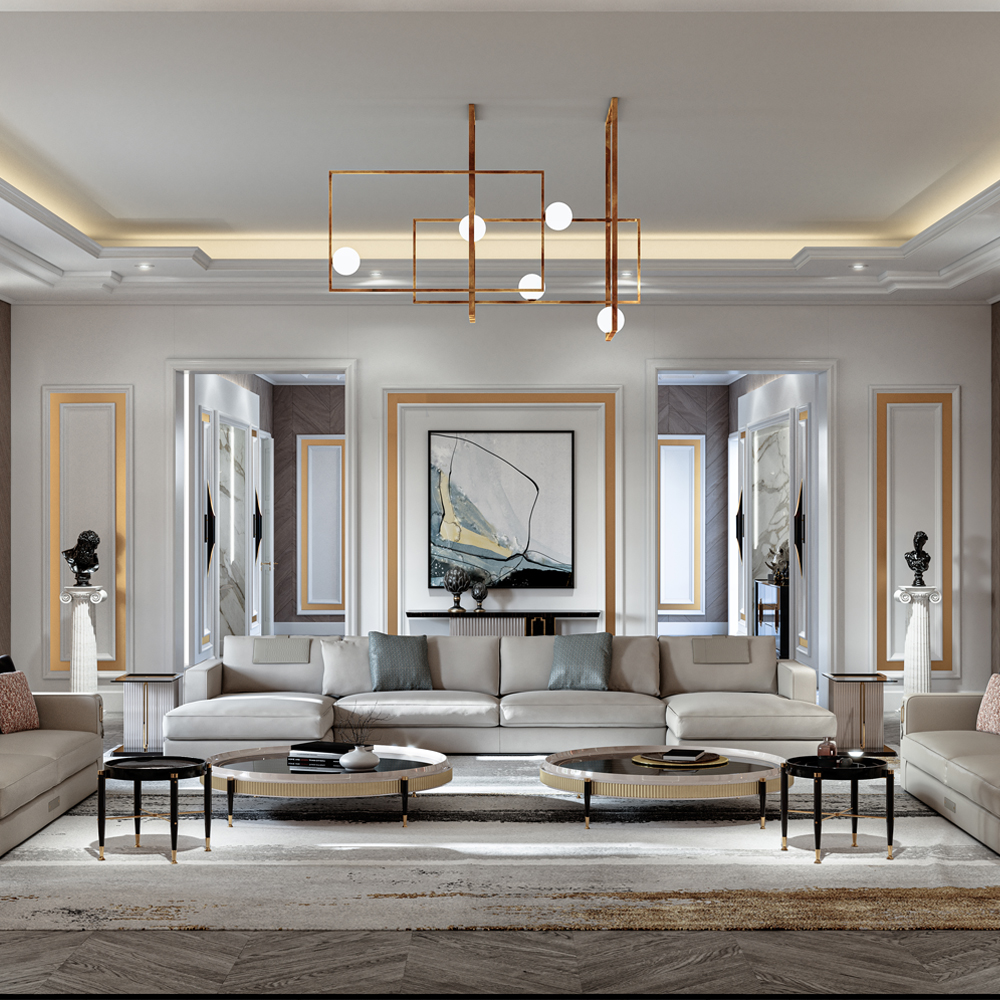
Living room design inspiration
Any interior design process needs to start by putting together your inspiration and design ideas. We are after all creating visual spaces, so collating visuals is a great starting point. Creating mood boards is a way to curate aesthetic inspirations. To begin the mood boarding process you should collect images that represent the look, feel and general vibe you are trying to create in your living room.
There are four key elements you should consider and collect images and visuals that represent:
- Colour
- Texture
- Material
- Mood
It’s important to note that images and visuals do not have to be interiors related, it’s a great idea to add in abstract images as well. This can convey a feeling, an essence and a general vibe, where interior images may not capture the spirit of what you want to achieve. Often only focussing on interior sources for design ideas can be limiting at the starting point, abstract ideas and visuals give us more creative freedom. Mood boarding is the first step in helping refine the direction you want to go in. There are fantastic tools like Pinterest you can use online, but we also are big fans of physical mood boards, helping you get a feel for the texture and material as well as the aesthetic elements.
When working with an interior designer this is an essential step in defining your brief and helping you co-create the vision for your living room. It gets the visual ideas you have in your head, down onto paper, combining all these ideas to see how they work together and ultimately forming a plan for how that translates into your space.
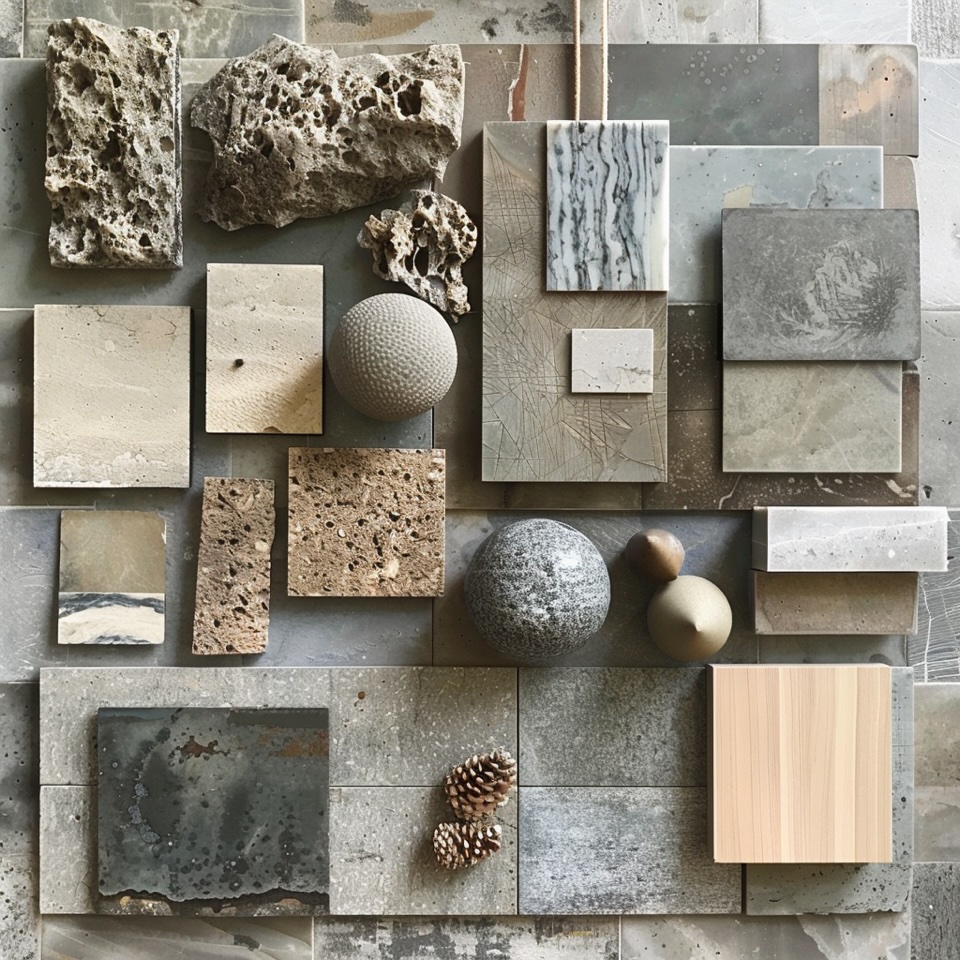
Colour scheme
Colour theory plays a huge part in your living room design. With 1000s of colours to choose from, we need to consider four elements of colour value:
- Hue – colour at full saturation
- Tint – adding white to colour
- Tone – adding grey to a colour
- Shade – adding black to a colour
Combining different colours together can create different effects, for example, dark next to bright makes the bright colour look brighter. Warm tones next to cool tones will look warmer and vice versa. Warm colours tend to make your living room feel cosier and can make them feel smaller, whereas cool colours tend to be more calming and make a space feel bigger and more open. This also applies to neutrals you can have warm and cool neutrals such as warm or cool greys, whites, and creams.
When choosing the colour scheme for your living room you have 5 key colour theories that can help you.
5 key colour theories:
- Monochromatic – different shades, tones and tints of the same colour
- Analogous – 3 colours next to each other on a colour wheel
- Complimentary – opposite colours on the colour wheel
- Split complementary – instead of just 2 opposite colours, using two opposite colours on each side of the opposite colour
- Triadic – 3 colours equally spaced apart on the colour wheel
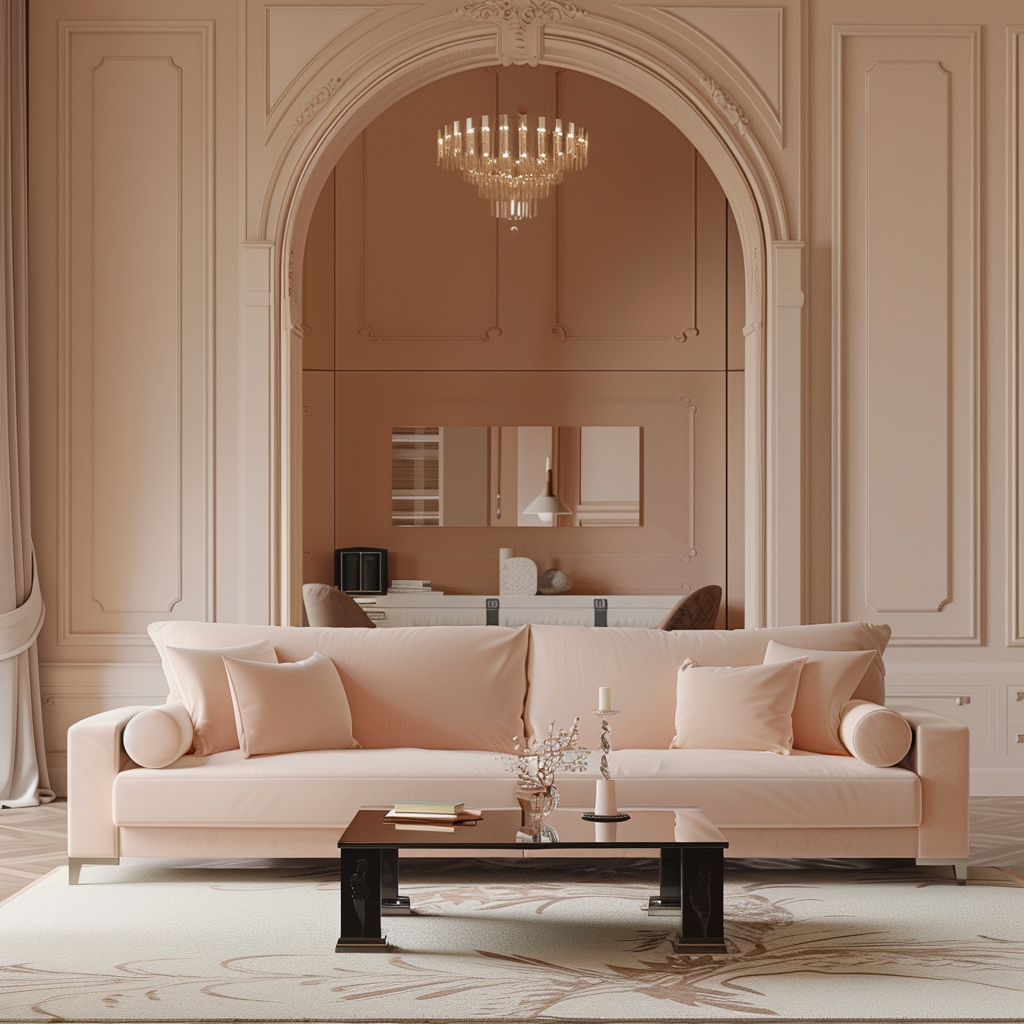
A colour scheme can make or break a room’s aesthetic, the mood and feeling those colours create can completely change the experience you have in that room as a result. Colour theory and colour scheme planning can take an expert eye. When starting your living room interior design project this can feel overwhelming, given the major role colours play in creating a harmonious and balanced look.
Working with an interior designer with extensive experience in colour pairing can make this journey less daunting and elevate the experience to something quite frankly enjoyable. Interior designers have a suite of tools and techniques at their fingertips and will guide you through a collaborative process. You likely already have a good idea of colours, but with a designer’s touch, you can transform those thoughts into a unique and breathtaking colour scheme.
Space planning
Space planning can make or break an interior design project. With so many factors to consider, this is where the expertise of an interior designer can really help. To be truly effective in space planning for your living room it needs to be functional in meeting all the desired intended uses, efficient in achieving your goals for within the space and of course aesthetically pleasing.
This starts with defining:
How will the space be used? As a multifunctional space, your living room needs to accommodate more than one function. Determining the primary purpose for the room, plus all other functions you need to accommodate for.
How many people will be using the space? What age are they? What’s their designated purpose in using the living room?
Understanding the day-to-day usage of a space really helps define layout, flow, furniture sizing and lighting requirements. So being clear on this before you create your floor plans, will enable you to make the best use of the space, large or small, and achieve the best layout possible to marry functionality and beauty.
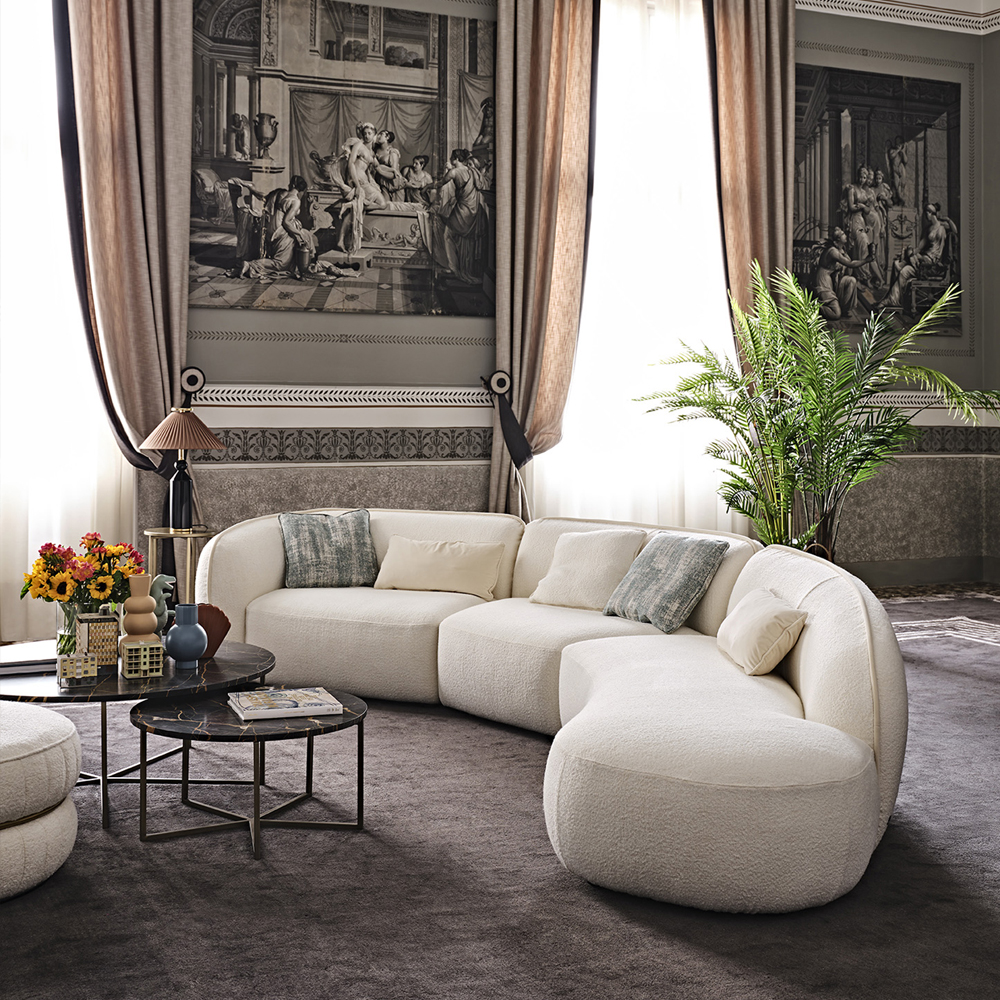
Here are some of the factors that need to be considered when planning your living room layout:
Living room features
What fixed elements do you have in your living room? These are fixed elements within the room such as fireplaces, columns or pillars and windows.
Focal points
What are the focal points for your living room? A focal point is something that stands out and the first thing you notice in that space. Focal points can be features, for example a fireplace may be a desired focal point in your living rooms design. However focal points don’t always have to be fixed features, these can be created within your design plan. So, identify what focal points you need to create and those you want to accentuate from features that are already there.
You can have more than one focal point in a room, this is especially relevant for larger living spaces, this does need careful consideration as too many focal points can create an overly busy feeling making a space overwhelming. When used correctly focal points can create zones and highlight different functions within a room.
Natural light
Light is really important to the space orientation of your living room and how that change throughout the day. Natural light plays a big part in enhancing the ambience and functionality of the space. By considering the direction and intensity of available sunlight, you can optimise the placement of furniture, colours, and decor to create a welcoming and vibrant environment, ensuring your living room is always inviting.
The availability of natural light in your living room is also crucial in aligning your design with your desired vibe. By strategically utilising natural light, you can curate the right mood for your living room to perfectly match your vision.
Existing living room furniture
Unless you’re working on a room from scratch, perhaps a property you are building or renovating, it’s likely you will have some existing exquisite living room furniture that needs to be incorporated into your new designs.
The living room is a more complex room to plan for, given its a multifunctional multipurpose and multi-person space. A bedroom or a bathroom has typically one primary function, whereas you’re the living room can have many.
Referring back to the desired uses for the room, and analysing the way people move through the space, what is the traffic flow, where are the entrances and exits, what are our functional elements and what areas do we need in the space?
In a living room the areas needed could be:
- Seating area
- TV area
- Relaxation spot
- Reading corner
- Area for working or homework, desk / office space
- Bar space for entertaining
The possibilities multiply with open-plan living or broken plan living, zoning is an essential component in effectively mapping the space.
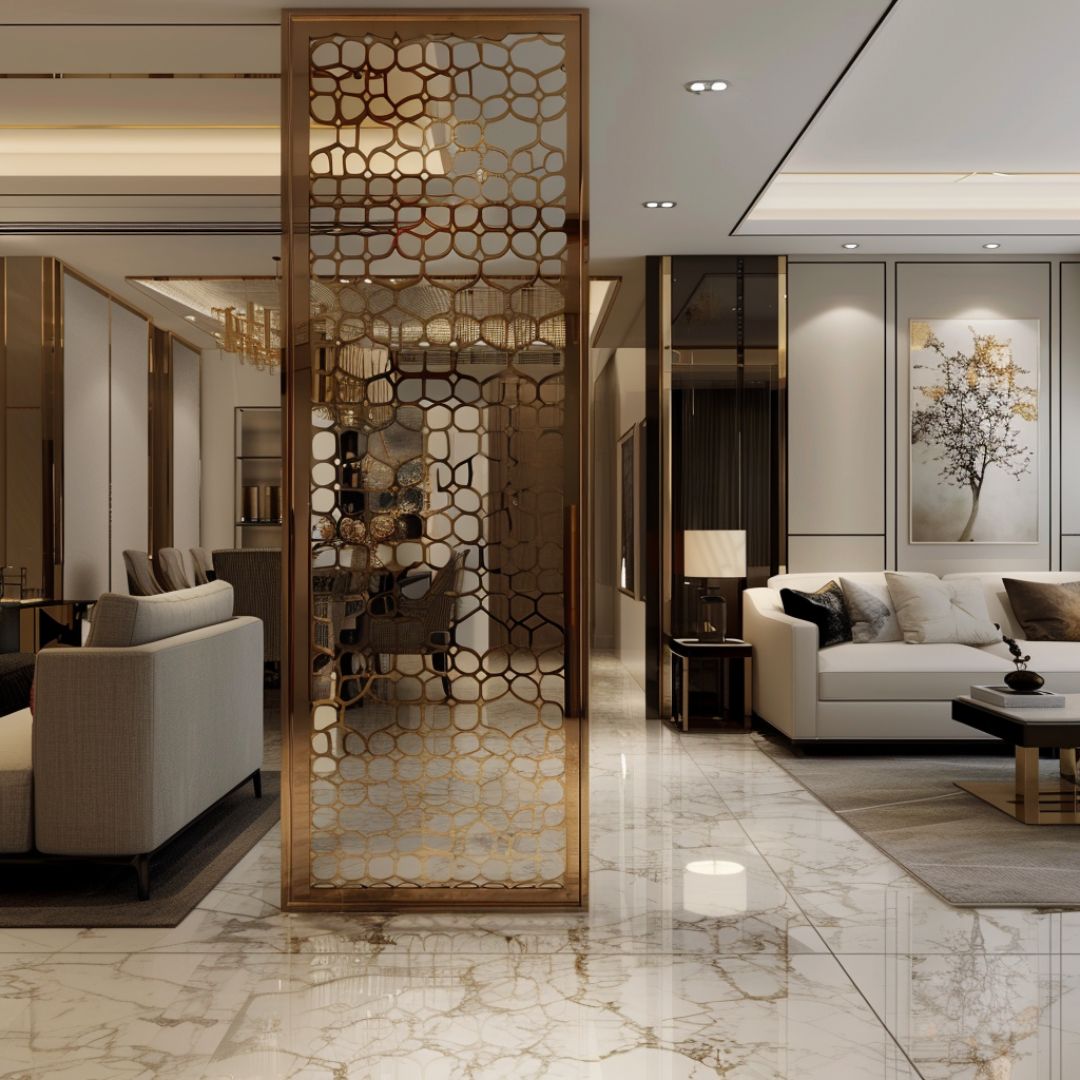
Using a measured floor plan and testing different zoning areas on paper, will help you visualise and quickly test different layout options. Once you have one two or three possible layouts, you can then start mapping areas and furniture you need to work in. It’s ideal to work to scale at this stage, so you get an accurate picture of your layout.
This early in the design process, you won’t have selected all your furniture so the exact sizes will not be known. However, for existing pieces you are keeping be precise, for anything new you can allocate rough measurements of a typical sofa or coffee table. With the furniture in place on your floor plan you can plan circulation to see if there are any issues or areas of oversight and adjust accordingly.
Creating accurate floor plans is a skilled task, and their precision is vital to prevent any costly mistakes. This is where working with an interior designer can save you a lot of headaches and money. Not only will they take on the task of producing accurate floor plans but use their experience to adapt and adjust those plans to accommodate your vision and requirements. They ensure that every detail is accounted for, from the best use of space to ensuring your furniture fits seamlessly into your home. They consider everything from the smallest detail to the big picture of a harmonious and cohesive design.
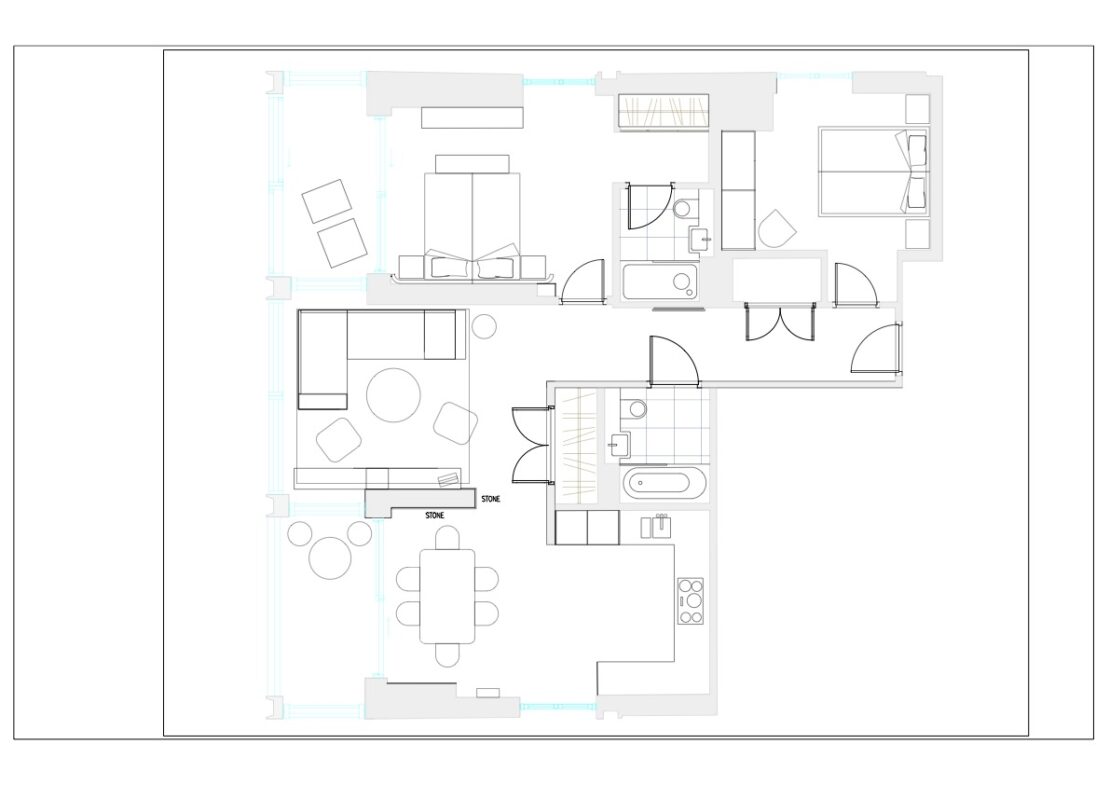
Selecting living room furniture
When selecting your living room furniture, the following points need to be considered:
- Style and colour
- Use and user
- Size
- Materials
- Cost
- Durability
- Comfort
- Fit for purpose
Analysing your mood board
Referring back to your mood board for your desired mood and style direction. Looking at the shapes and forms used. Is it organic or geometric, heavy or light, open or closed forms? Take in how your colours relate to each other, the ratio of say main colours to accent colours. Then look at the textures and materials you have represented in the mood board. You may also find writing down 3-5 descriptive words which sum up your mood board for example serene, feminine, organic. This process will help you create a set of guidelines for selecting your furniture.
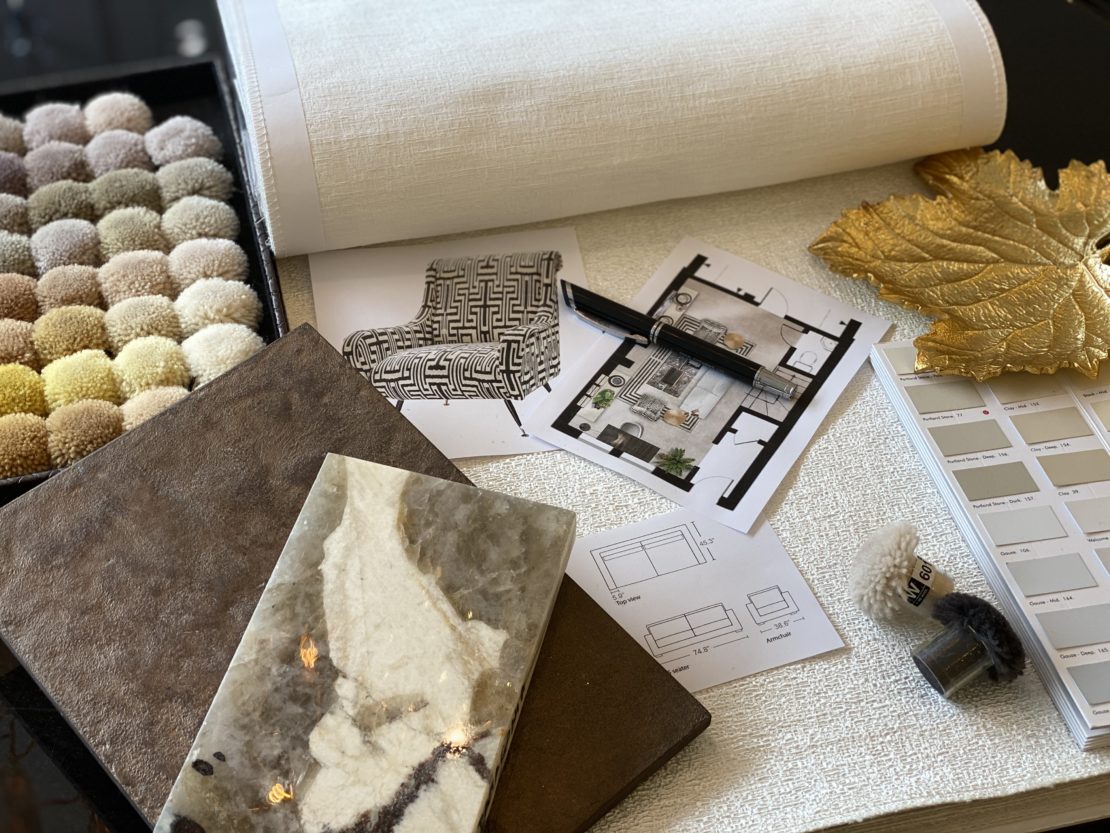
As well as each piece of your living room furniture meeting the specifics above, you also need to consider:
- Getting that piece to the desired room
- Assessing the best routes for access
- Measuring widths and heights of corridors and entranceways of the access route
- Staircases, tight corners can be difficult to manoeuvre through
Not planning for the access route as well as the space itself is a common interior design mistake. For example, your new sofa may fit perfectly in the designated area in your living room design plan, but on delivery it won’t fit through a doorway. Or perhaps your hallway has lower ceilings than those in the living room making it impossible to get your new bookcase through. Experienced interior designers will be adept at making an assessment of the space and required access, to ensure a seamless fit from the delivery truck to its desired place in your living room.
Living room interior design: Selecting the right materials and finishes
With so many materials and finishes to choose from, it can often be daunting to know where to start. Understanding the different properties will help narrow your selection.
Fabric:
There are two main categories of fabrics natural and synthetic. Whilst there is a huge array, these are the most common characteristics:
Natural fabrics derived from nature: Cotton, Linen, Silk, Leather
Luxurious texture or feel, breathable fabric.
Crease more easily, slower to dry.
Synthetic fabrics are man-made fibres: Nylon, Polyester, Rayon
Do not crease as easily, dry quicker.
Another consideration is the rub count, which is used to determine the durability of the fabric and therefore its suitability for certain uses. Your sofa, for example, will require a higher rub count than your curtains, as it will get more wear and tear.
Flooring:
Selecting flooring for your living room is a big decision, not only will it be a significant portion of your budget, but you also need to consider the installation and maintenance.
A living room is a high traffic space, potentially with pets, children and visitors. So, flooring needs to be carefully selected that is not easily marked or scratched, is easy to clean and above all is very durable.
It’s always best to get advice and samples of your potential living room flooring before you commit to your final choice. Another common interior design mistake when selecting flooring is not taking into account the thickness of the flooring, which can lead to issues such as misaligned door heights, uneven transitions between rooms, and difficulties with furniture placement.
Whilst interior designers aren’t experts in every fabric and finish, they consult with their expert suppliers and leverage their existing knowledge to suggest the perfect materials and finish to fit your purpose.
Wall finishes:
The wall finishes will undoubtedly have the greatest impact on the look and feel of your living room, due to the large surface area walls take up in the space. It’s vital to consider how these colours, textures and patterns will all work together but also how they will be used in your living room. Referring back to your living room design plan, assessing against uses, and users, focal points, features, natural light as well as the maintenance and durability of your selections.
Selecting the right sofa
The living room serves as a multifunctional hub in any home, adapting to various needs and activities. It’s a place for relaxing after a long day, whether that means curling up with a good book or watching your favourite TV shows. It’s also a space for entertaining guests, offering a welcoming environment for socialising, enjoying drinks, or hosting game nights. Family gatherings find a natural home here, with the living room needing to provide a comfortable setting for spending quality time together, from casual conversations to festive celebrations. At the heart of any living room, is the sofa, it sets the tone for the entire space.
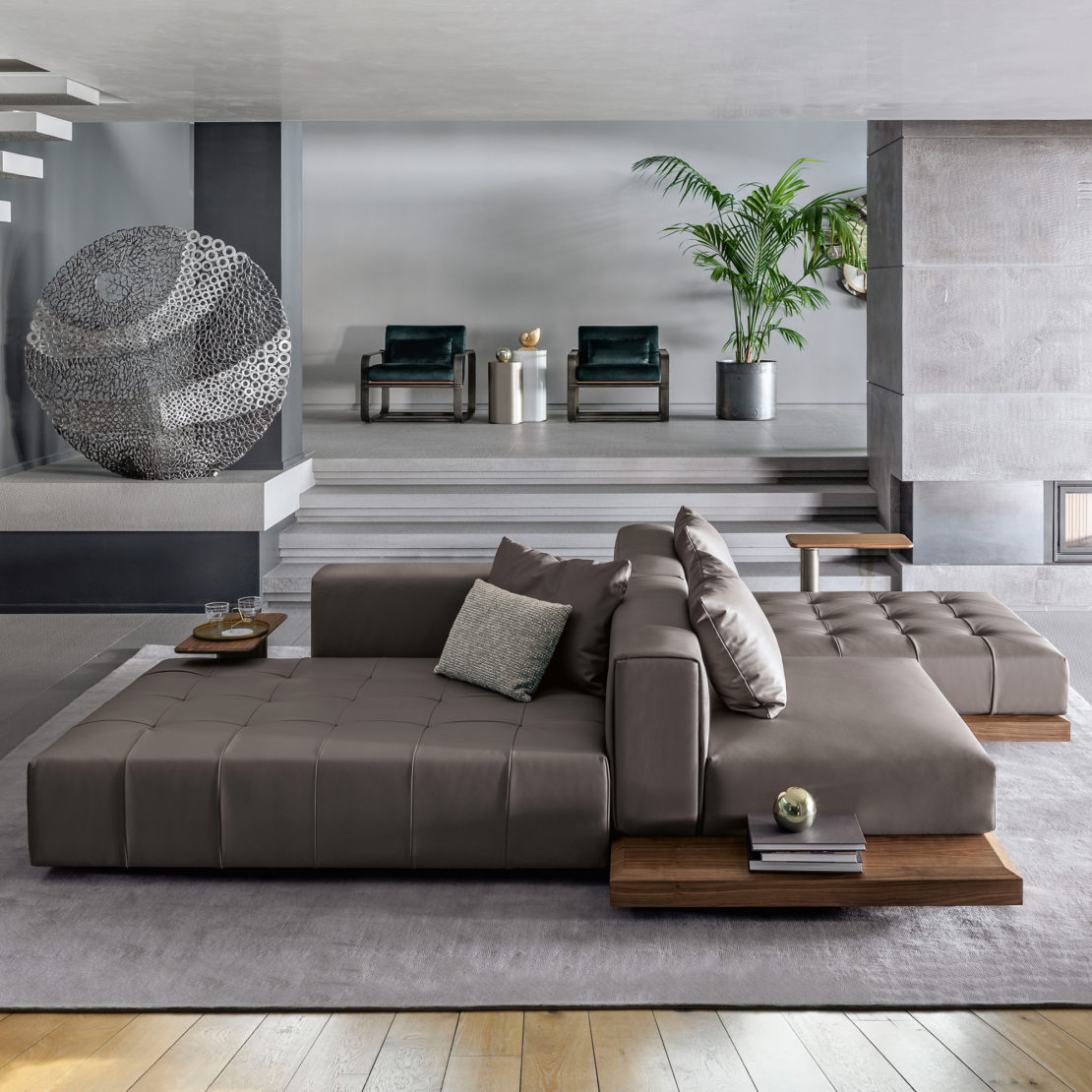
Choosing the right sofa is a key decision that balances style, material, and functionality, especially for multigenerational living. Given its central role and frequent use, it’s essential to view your sofa as an investment piece—always opt for quality.
Styles vary widely, from sleek contemporary sofa designs that offer a modern edge to opulent Art Deco pieces that add a touch of glamour, or Louis-inspired sofas that bring a sense of regal sophistication. For added flexibility and creativity in your room layout and design, a modular sofa can be an excellent choice. Allowing you to adapt the seating arrangement to fit your needs.
Make your sofa fit the space, not the other way round. Going bespoke with custom designed furniture is often the best approach. Creating the perfect sofa that meets your aesthetic preferences and functional needs, made to measure for your exacting requirements.
Armchairs and occasional seating
Whether you’ve opted for a large luxury sofa with enough space to fit the whole family, the comfort and opulence of your living room doesn’t end there. Incorporating armchairs, occasional seating, and accent pieces like chaise longues, pouffes, and footstools significantly enhance the comfort, flexibility, and aesthetic appeal of your living room.
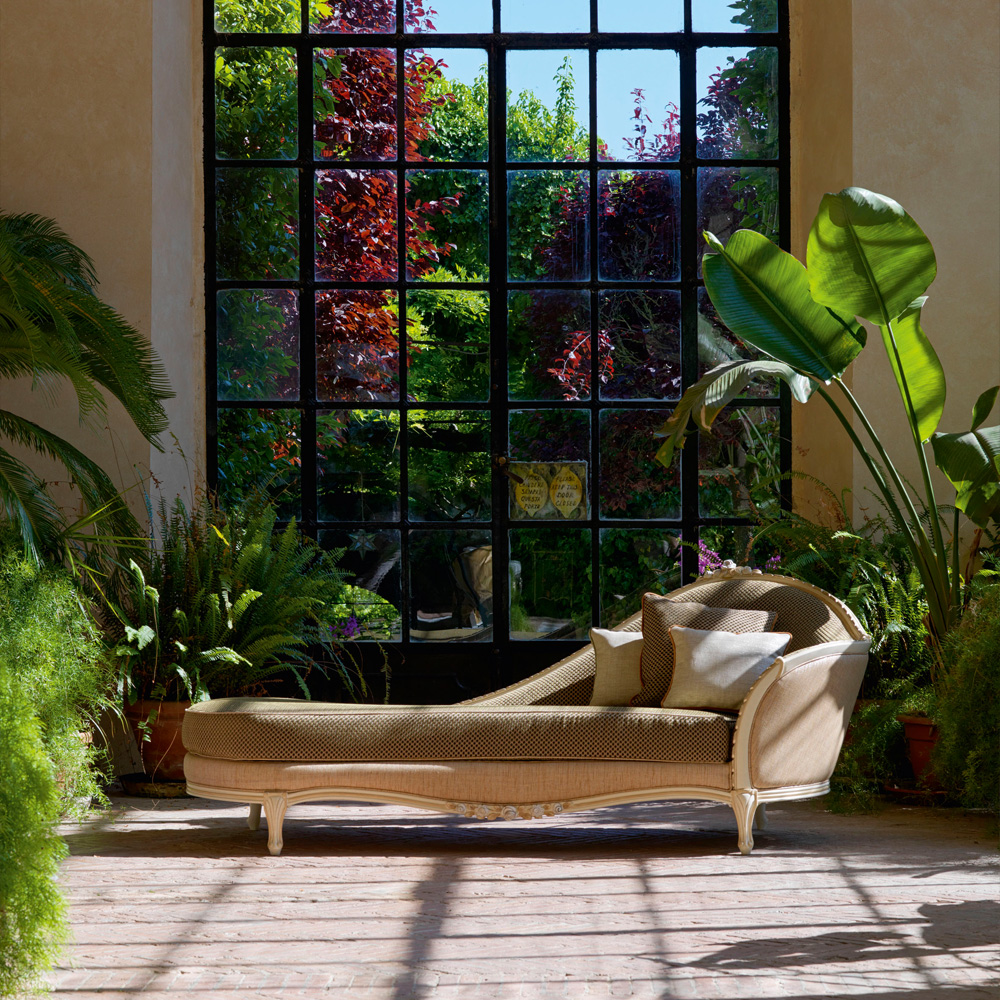
Armchairs and additional seating options offer areas for individual activities whether that’s relaxation, morning rituals, working from home, or enjoying a quiet conversation. Sink into the sumptuous splendour of a luxury armchair to enjoy a good book, or choose a refined, elegantly designed chair to savour your morning coffee while gazing out the window.
Occasional seating, such as stylish accent chairs, can be easily moved around to accommodate guests, ensuring everyone has a comfortable place to sit. Accent pieces like chaise longues add a touch of luxury and serve as focal points, drawing the eye and elevating the room’s design. Pouffes and footstools not only contribute to the room’s comfort but also provide versatile options for seating or resting your feet.
Luxury living room interior design: creating the right lighting scheme
A well-planned lighting scheme can make all the difference in your living room interior design. Get it right, and you have ability to create the ambience throughout the day and night. Get it wrong, and you either have a dull, gloomy space or one that feels like a dentist’s waiting room.
Layered lighting is the key. Incorporate ambient lighting to provide overall illumination, task lighting for activities like reading or working, and accent lighting to highlight focal points and create warmth.
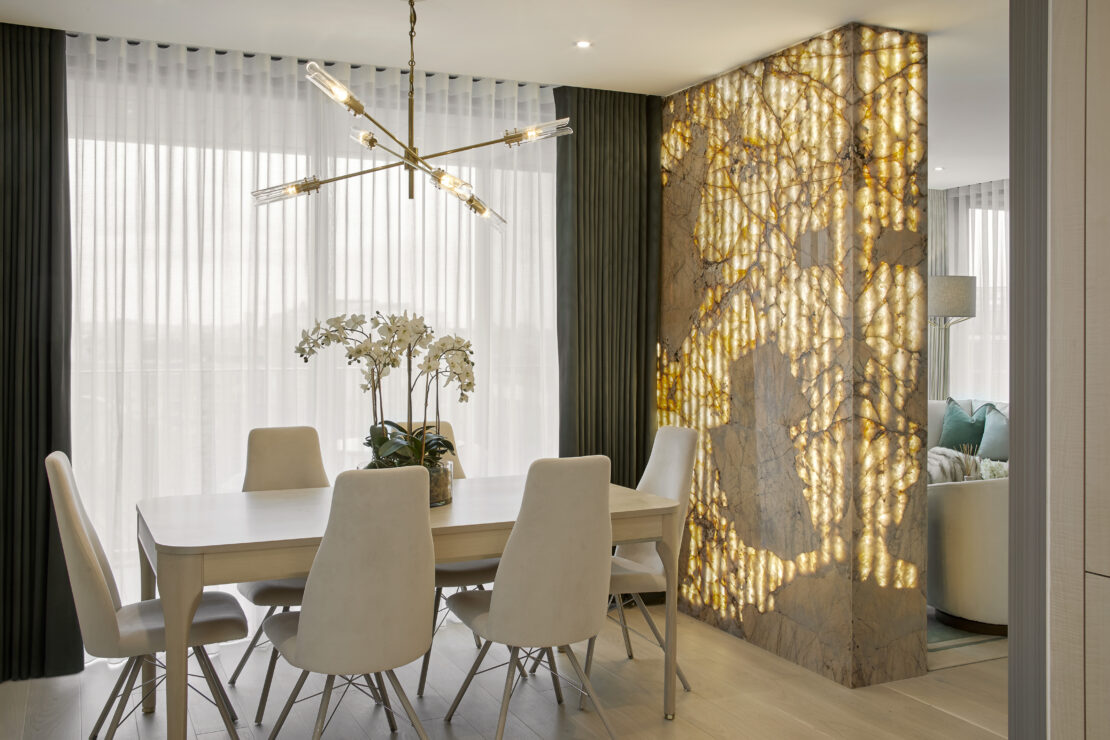
Ceiling lights
Ceiling lights are often the primary source of light in a living room. Adding a magnificent chandelier can make a superb focal point, with modern or classic styles to fit any design aesthetic. For example, a glass chandelier can elegantly radiate light throughout the room, casting sparkling light in every direction and creating a mesmerising effect.
If your room is better suited to something less grandiose, opting for modern simplicity, geometric shapes or floor to ceiling contemporary lighting can create the same wow factor in an understated way.
Think of where you might sit to read or watch TV. Use brighter task lighting for reading and working, then add a combination of wall lights, floor lamps, and table lamps to create a cosy and inviting atmosphere. By thoughtfully layering your lighting, you can enhance the functionality and aesthetics of your living room. Making it a versatile and welcoming space.
Accent lighting
Using a combination of wall lights, floor lamps, and table lamps as accent lighting in your living room can significantly enhance the ambience and functionality of the space.
Here’s how you can effectively incorporate these lighting elements:
Wall lights:
Install wall lights to add a layer of ambient lighting that gently illuminates the room without overpowering it. Wall lights can be strategically placed to highlight artwork, and architectural features, or to create a warm, inviting glow along the walls. They are perfect for adding depth and creating a plush inviting atmosphere.
Table lamps:
Place table lamps on side tables, consoles, or shelves to create pools of light that add to the overall ambience. Table lamps are ideal for providing soft, localised lighting to build the perfect mood for the room. Use them to add a decorative touch and to create intimate spaces, they’re perfect to adjust the lighting as needed.
Floor lamps:
Floor lamps are versatile and can be moved around to suit different needs. Position a floor lamp next to a reading chair or sofa to provide ambient lighting for reading or working. Choosing lamps with adjustable heads can give you the opportunity to direct light where it’s needed most. Floor lamps can also add height and interest to your room’s decor, filling vertical space and creating visual balance.
Task lighting:
Purposeful lighting is essential for creating functional and well-lit areas in your home, especially when it comes to activities that require focused illumination. Table lamps are perfect for providing targeted light for reading, writing, or working on a laptop, adding both practicality and style to your side tables or desks. Reading lights, often with adjustable arms, can be placed next to armchairs to provide direct light exactly where it’s needed, ensuring comfort and reducing eye strain.
Cabinet lighting for display cabinets and armoires not only highlights your treasured collections but also enhances the overall aesthetic of the room. These lights can be discreetly installed inside or under the cabinets to illuminate the contents, creating a captivating display and adding an elegant touch to your interior. Together, these task lighting options ensure that the desired areas of your living room are both beautifully lit and highly functional.
By thoughtfully combining these different types of lighting, you can create a layered and dynamic lighting scheme that allows you to adjust the ambience throughout the day. This approach not only aids the functionality of your living room but also ensures a warm, inviting, and stylish space for any occasion.
Coffee tables and side tables
Coffee tables and side tables play a crucial role in luxury living room design, seamlessly blending form and function while heightening the room’s overall aesthetic. When selecting these pieces, consider their height and proportion to ensure they complement your seating arrangements and provide ease of use. A coffee table should be roughly the same height as the seat of your sofa for comfort and accessibility, while side tables should be level with or slightly lower than the arm of the chairs they accompany.
In addition to their practical uses for holding drinks, books, or decorative items, these tables can serve as key elements in zoning different areas within the living room. A statement coffee table can anchor the central seating area, creating a focal point and grounding the space. Meanwhile, strategically placed side tables can delineate zones, such as reading nooks or conversational clusters, adding both structure and flow to the room’s layout.
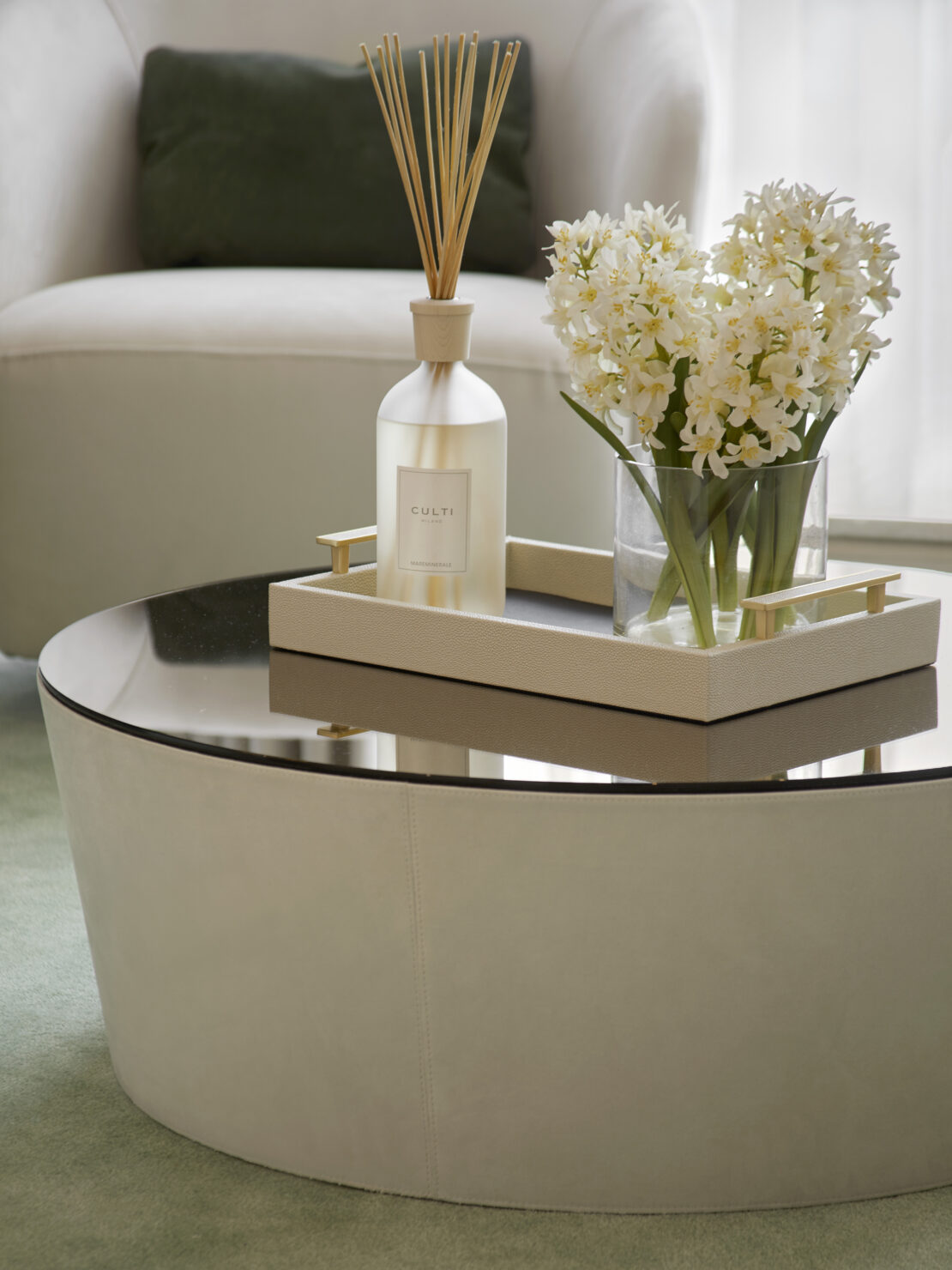
Luxury materials like marble, glass, and high-quality wood, combined with intricate detailing and elegant finishes, elevate these tables from mere functional pieces to works of art. By thoughtfully integrating coffee tables and side tables into your design, you enhance both the beauty and utility of your living room, creating a harmonious and inviting space.
Sideboards and display cabinets
Luxury display cabinets and sideboards are not always essential pieces of living room furniture. However, when designing a high-end living room, these pieces provide elegant storage solutions. Helping to keep the space organised and clutter-free while showcasing your exquisite taste. Sideboards, serve as a stylish foundation for decorative items and artwork. Display cabinets, often with their glass doors and refined finishes, allow you to beautifully present your most cherished collections, from fine china to art pieces. Sideboards and display cabinets enrich the sophistication of your living room, adding depth and character to the overall design.
Mirrors
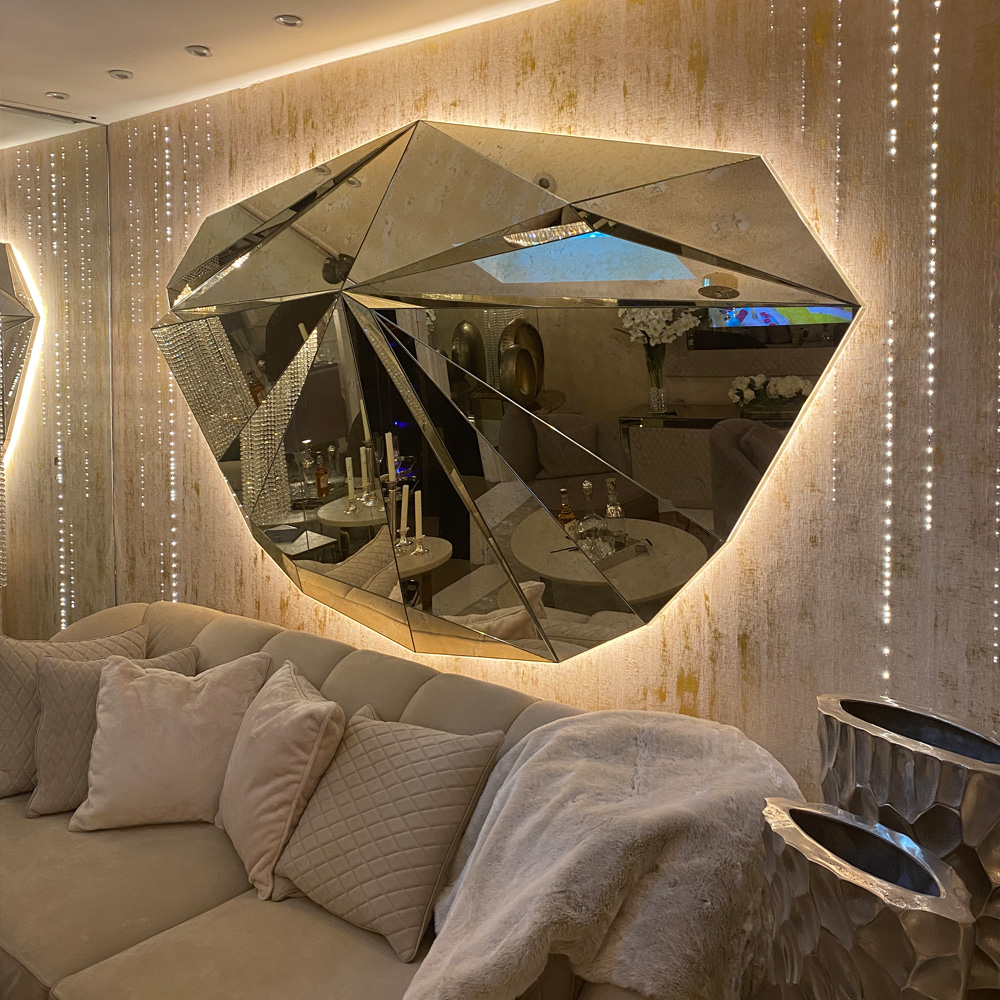
Luxury mirrors are a powerful design element in any room’s design, especially so in a living room. Strategically placed mirrors can amplify natural light, making the space feel brighter and more expansive. They create an illusion of depth, boosting the room’s overall sense of grandeur and openness. Ornate, framed mirrors serve as stunning focal points, adding a touch of elegance. Whether used to reflect beautiful artwork, capture scenic views, or simply enrich the room’s opulent decor, mirrors are an indispensable tool in creating a luxurious and visually captivating living space.
TV furniture
In a luxury living room, TV stands, media consoles, and entertainment centres should be carefully chosen to complement the room’s overall aesthetic while providing ample storage and organisation for electronics and accessories. When thinking about your TV furniture what features do you need it to have? For example, integrated cable management systems to keep wires neatly out of sight. Adjustable shelving for customisation, and soft-close drawers and doors for a touch of luxury. Additionally, designs can incorporate built-in lighting to highlight the unit’s features and create a warm ambience.
Beyond functionality, TV furniture can serve as a focal point in the living room, with designs ranging from minimalist and contemporary to ornate and classic. Choosing the right TV furniture not only ensures that your entertainment system is seamlessly integrated into your living space but also adds a layer of elegance and refinement, enhancing the overall look and feel of your room.
Luxury rugs
Luxury designer rugs serve as both a foundational piece and can be a focal point, anchoring the room’s decor and enhancing its overall aesthetic. Placed over your carefully selected flooring, luxury rugs enhance its beauty and protection. Beyond their visual appeal, rugs provide comfort underfoot, help define different zones within a room. They can even improve acoustics by absorbing sound.
As with your main flooring considerations select high-end materials and high-quality blends, for unparalleled softness and durability. Whether a designer rugs features intricate patterns, rich colours, or a more simplistic and chic style, they must have exquisite craftsmanship and attention to detail.
Luxury living room interior design: Finishing touches
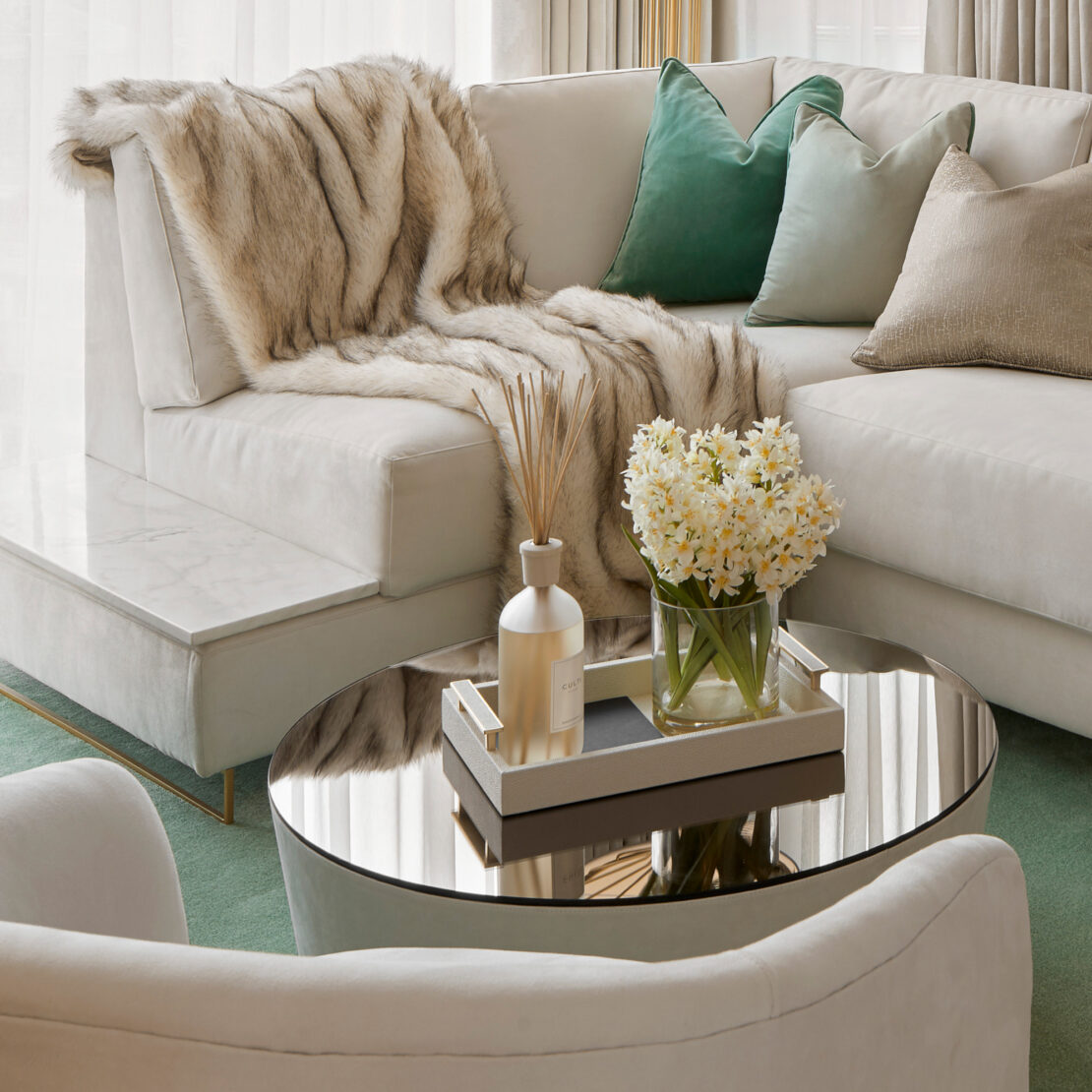
With all your main luxury living room furniture carefully selected and designed to meet your exacting requirements, you can begin to curate the finishing flourishes. Such as cushions and throws, ornaments and urns, planters and vases, artwork and so much more. This is where you really add some personality, but remember to keep to your desired style, mood and vibe so you don’t end up with too many conflicting pieces. Contrast can be a powerful design tool if used divisively, but too much variation can create a sense of conflict, leaving you feeling overwhelmed and confused.
So there you have it, our comprehensive luxury living room interior design guide, with concepts, insights, tips and tricks for every stage. There’s a lot to think about at every stage, with so many factors you may want to consider working with an experienced interior designer to support you in bringing your vision to life.
Why work with an interior designer?
Working with our award-winning interior designers can transform your living room interior design experience. Our team brings extensive expertise, creativity, and a trained eye to help you refine and define your style. We offer unparalleled service through a collaborative and elevated process, ensuring you get not only exactly what you want, but that your jaw-dropping designs exceed all expectations.
Working with an interior designer can prevent costly mistakes and ultimately should save you money, time and stress. Our designers work diligently to keep your project on time and within budget, reducing stress and ensuring a seamless experience. With careful curation of luxury furniture pieces or bespoke designs crafted uniquely for you, we leverage a vast network of master craftsmen and artisan producers to create a truly personalised and exquisite living space.
Living room interior design, London UK
If you wish to find out more about interior design, to book an appointment at our London Showroom. To discuss your project with one of our designers, please contact Juliettes Interiors. By phone +44 (0) 203 131 4515 or email us at sales@juliettesinteriors.co.uk
